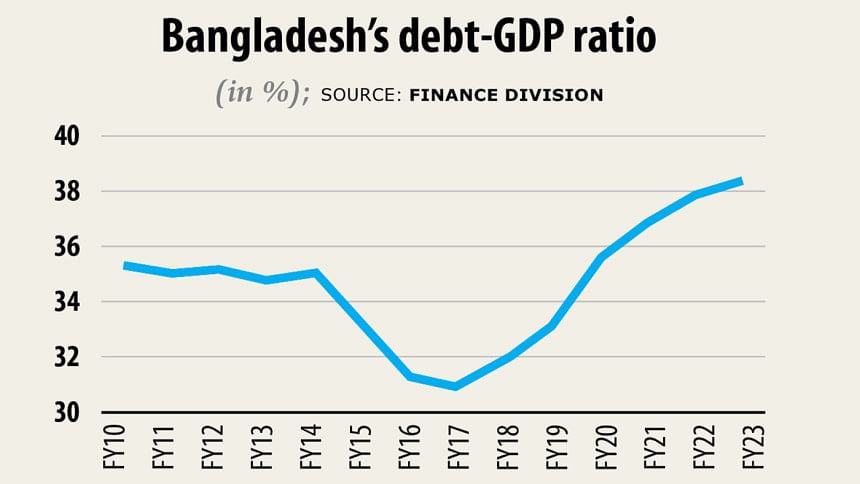Pandemic nudging Bangladesh’s debt-to-GDP ratio out of comfort zone

The coronavirus pandemic is turning out to be a quite a costly affair for Bangladesh, due to which its public debt-to-GDP ratio, which has thus far been in a healthy position, is set to exceed the responsible threshold of 40 per cent.
In the coming years, Bangladesh's public debt-to-GDP ratio, which stood at 36 per cent at the end of 2019, would swell to about 41 per cent owing to increased borrowing to safeguard both lives and livelihoods, the International Monetary Fund said.
"Even so, debt should remain sustainable," said Ragnar Gudmundsson, resident representative for Bangladesh of the IMF, on the crisis lender's website.
In a way, this is a testament to the sound economic and fiscal policies implemented in recent years, with limited aid dependency, prudent borrowing and, up until the crisis, adherence to a deficit ceiling of 5 per cent of GDP.
"Before the crisis, Bangladesh was in a very good position, with a low risk of overall and external debt distress," Gudmundsson said.
One of the most densely populated countries in the world, Bangladesh exemplifies the triple blow that many emerging market countries have suffered from the pandemic: domestic slowdown caused by the disease and the efforts to contain its spread; a sharp decline in exports, particularly of its main product garment, and a decline in remittance.
This has left Bangladesh suddenly requiring additional funds.
But the updated debt sustainability analysis capturing the impact of the pandemic shock shows that debt remains at low risk of debt distress, the IMF said earlier this month while approving $732 million in emergency financing.
Despite the adverse shock to growth and exports, all external debt indicators are below their respective thresholds under the baseline and stress-test scenarios.
Public debt also remains below its indicative benchmark under the baseline and stress-test scenarios, it said.
Higher economic growth, limited revenue shortfall, the right mix of credit and stable foreign currencies helped keep the public debt-to-GDP ratio at about 35 per cent for a decade from fiscal 2008-09.
The government has unveiled various stimulus packages amounting to $103,117 crore, which is 3.7 per cent of the country's gross domestic product, to help people, businesses, entrepreneurs, farmers, industrialists and exporters counter the impact of the pandemic.
The stimulus packages are the second-highest among the peer countries in Asia and the highest in South Asia.
As a result, the total outstanding debt expanded by 1.7 percentage points of GDP in the revised budget for fiscal 2019-20 from the original one, the paper said.
The debt level would go up by another 1.2 percentage points to Tk 117,000 crore in fiscal 2020-21 when most of the stimulus packages would be implemented. Domestic debt would account for 63 per cent and the external financing 37 per cent in the next fiscal year.
The cost of funds for foreign financing is still lower than domestic financing although external borrowing entails some foreign currency risks.
Any devaluation of local currencies immediately increases the cost of overseas borrowing, the finance division paper said.
It would be relatively cheaper to finance the budget deficit relying on the external sources and an appropriate mix of foreign and local loans would help cut financing debt expenditure and the overall outstanding debt.
The budget deficit for this fiscal year was estimated at Tk 145,380 crore. However, the deficit in the revised budget has been set at Tk 153,513 crore, which is 5.5 per cent of GDP.
The overall budget deficit in fiscal 2020-21 will be Tk 190,000 crore, which is 6 per cent of GDP.
It is expected that the economy would receive momentum on the back of the implementation of the stimulus packages and the central bank's expansionary monetary policies, prompting the government to project 8.2 per cent GDP growth in the next fiscal year.
The growth projection is higher than 5.7 per cent forecasted by the IMF.
The reforms of debt management, the lower interest rate in the international market and higher GDP growth would create a congenial environment for credit management in the near future, the finance division said.
"So, an uptick in the debt-to-GDP ratio would not emerge as a matter of concern in the medium term."
Experts, however, suggest caution.
In the developed countries, the revenue-to-GDP ratio is 30 per cent to 35 per cent and the debt-to-GDP ratio is 70 to 100 per cent. This brings the debt-to-tax ratio to 300 per cent, according to Ahsan H Mansur, executive director of the Policy Research Institute of Bangladesh.
Bangladesh's revenue-to-GDP ratio is 8.6 per cent and debt-to-GDP ratio 35 per cent. This means Bangladesh has a debt-to-revenue ratio of more than 400 per cent, he said.
As a result, Bangladesh is one of the highest indebted countries in the world in terms of capacity to pay, he told The Daily Star yesterday.
"We have to be careful now. If the current trend continues, it will become unsustainable."
For Bangladesh, there is no scope for complacency and it has to accelerate revenue generation, the economist said.
The government has already cut its reliance on expensive national savings certificates. This would go a long way towards bringing down the country's debt servicing expenditure, the finance division paper said.
Foreign debt stood at $44.4 billion fiscal 2018-19, which was 13.4 per cent of GDP.
Bangladesh has had to pay $1.9 billion in principle and interest in the outgoing fiscal year, which is 5.1 per cent of the projected export incomes and 4.5 per cent of the revenue generation.
The threshold for foreign debt obligation for Bangladesh is 21 per cent of export proceeds and 23 per cent of government revenue, according to the World Bank-IMF's joint debt stability analysis of 2019.
This means, the foreign debt outstanding is far lower than the country could borrow, the policy statement said.


 For all latest news, follow The Daily Star's Google News channel.
For all latest news, follow The Daily Star's Google News channel. 



Comments